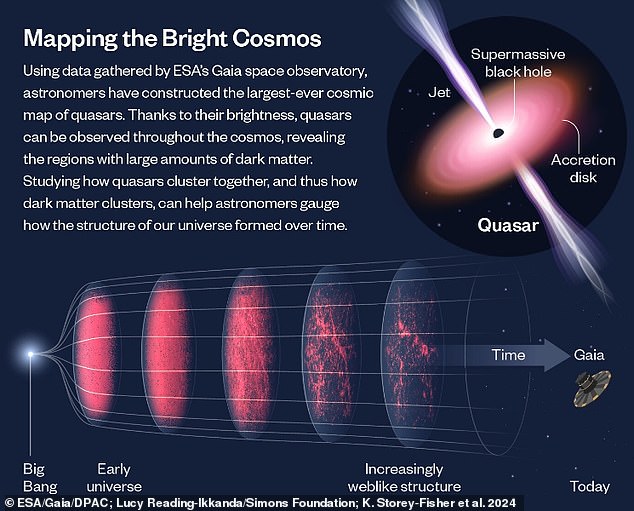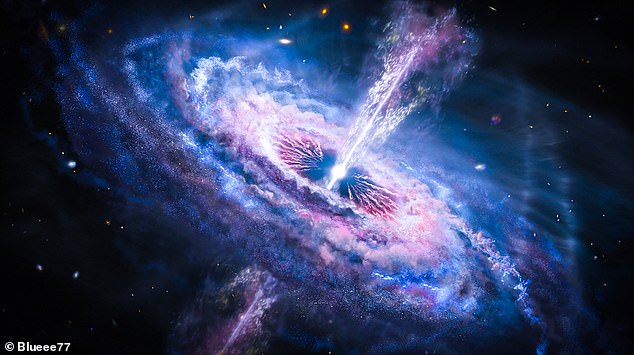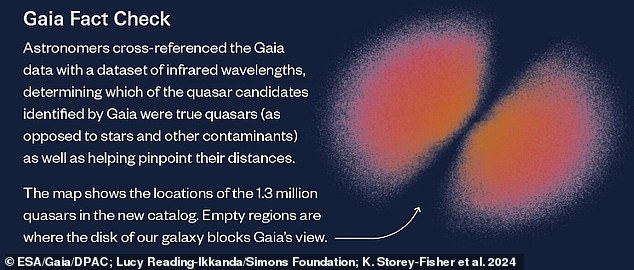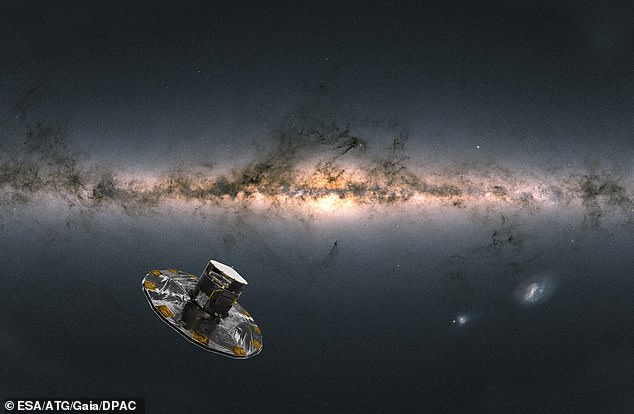Mapping the universe: Scientists create the largest ever map of active supermassive black holes – with more than a million voids
They are probably the most feared objects in the universe: enormous concentrations of dense matter that can swallow entire planets.
Now a stunning 3D map shows 1.3 million supermassive black holes living at the centers of other galaxies in the universe.
On the map, each black hole appears as a tiny red dot, almost like a liquid particle in a plume of colorful vapor.
But in reality, each has a mass millions to billions of times greater than the mass of the Sun, and is located thousands of light years away.
Researchers emphasize that this map does not show all the black holes in the observable universe – a figure believed to be a staggering 40 quintillion.
This graphical representation of the map shows the location of quasars from our vantage point, the center of the sphere. In areas where quasars do not occur, the disk of our Milky Way blocks our view. Quasars with larger redshifts are further away from us.
The map was created by an international team of astronomers led by David Hogg, professor of physics and data science at New York University, using data from the Gaia spacecraft.
Known as the inspiration for science fiction films like ‘Event Horizon’, black holes are regions of spacetime where the pull of gravity is so strong that not even light can get out.
They act as intense sources of gravity that suck in surrounding matter such as dust and gas, as well as planets and even other black holes.
The new map specifically shows ‘quasars’: supermassive black holes that actively feed on material and emit electromagnetic radiation, making them incredibly bright and clear.
“There are a lot of black holes – any reasonably sized galaxy probably has one at its centre,” says Dr Christopher Onken, an astrophysicist at the Australian National University in Canberra, who was not involved in the map.
‘But most of them are not quasars because they don’t eat enough material,’ he told MailOnline.
‘If there is enough material near a black hole, the matter flattens into a pancake shape and heats up to such high temperatures that it glows brightly enough to be visible very far away, and then we call it a quasar.
‘So the black hole is actually the heart of the quasar.’

An infographic explaining the creation of a new map of approximately 1.3 million quasars from the visible universe

Quasars are supermassive black holes that actively feed on material and emit electromagnetic radiation, making them incredibly bright and luminous (artist’s impression)
The new map records the location of about 1.3 million quasars in space and time, the farthest of which shone brightly when the universe was just 1.5 billion years old.
For comparison, the universe is now 13.7 billion years old.
The scientists built the map using data from the European Space Agency’s Gaia space telescope, which is about 1.5 million kilometers from Earth.
Although Gaia’s main purpose is to map the stars in our Milky Way, Gaia also inadvertently discovers objects outside the Milky Way, such as quasars and other galaxies.
The team used data from Gaia’s third data release, which contained 6.6 million quasar candidates, and data from NASA’s Wide-Field Infrared Survey Explorer and the Sloan Digital Sky Survey.
By combining the data sets, the team removed ‘contaminants’ such as stars and galaxies from the original Gaia data set and was able to determine the distance to the quasars more accurately.
They also mapped out where dust, stars and other ‘nuisances’ are expected to block our view of certain quasars, which is crucial for interpreting the quasar map.
“This quasar catalog is a good example of how productive astronomical projects are,” says Professor Hogg.
‘Gaia was designed to measure stars in our own galaxy, but at the same time it also found millions of quasars, giving us a map of the entire universe.’
Astronomers say the locations of distant black holes and their host galaxies could help them better understand how the cosmos has expanded over time.

The new map records the location of about 1.3 million quasars in space and time, the farthest of which shone brightly when the universe was just 1.5 billion years old

The European Space Agency’s Gaia Space Telescope (pictured here in space) is about 1.5 million km from Earth
Most, if not all, galaxies have monstrous black holes at their core, including our own Milky Way Galaxy.
When galaxies merge, their black holes ‘sink’ to the center of the newly formed galaxy and eventually come together to form an even more massive black hole.
As the black holes spin toward each other, they increasingly disrupt the fabric of space and time, emitting gravitational waves first predicted by Albert Einstein more than 100 years ago.
Professor Hogg and his colleagues present the map in a paper published in The Astrophysical Journal.
